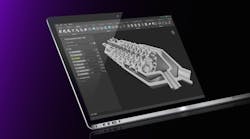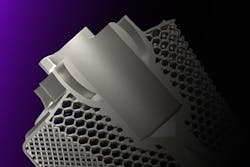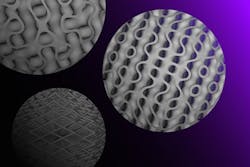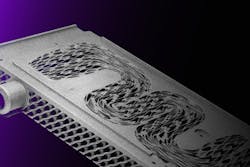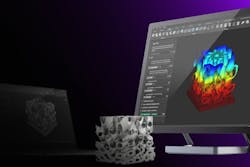Solving Complex Heat Transfer Problems With Additive Manufacturing & Advanced Design
Engineers face increasingly complex product requirements, making the need for thermal management tools and solutions paramount. Additive manufacturing and the appropriate engineering design software can enable you to design the next generation of innovative heat exchangers to meet these requirements.
Product designs are becoming more complex. They’re higher-powered, electrified, and digitally connected, which means that the heat generated by their transmission, power, and electronic subsystems is increasing. Despite this, the space available to manage this heat typically remains the same.
This trend requires next-generation heat exchangers that are more compact and efficient, and additive manufacturing enables engineers working across various industries to achieve this goal. But to make these superior heat exchangers a reality, you must combine the latest thermal management design techniques with advanced engineering design software.
This article will explore how you can use additive manufacturing and nTopology's advanced design software to solve increasingly complex heat transfer problems.
Thermal Management and Heat ExchangersThermal management is an engineering application that enables you to maintain adequate temperatures inside products and processes, significantly improving product reliability, lifespan, and performance.
Thermal management requires that the heat generated by a product’s various components and subsystems is properly managed. There are many techniques for managing heat transfer, but at the core of every thermal management system is a heat exchanger.
Heat exchangers move thermal energy from hot to cold regions. There are many types of heat exchangers, including radiators, cold plates, heat sinks, and oil coolers. You will likely find high-performance heat exchangers in aircraft and road vehicles, electronics cooling, and precision manufacturing.
The Need for Thermal Management Solutions Across Industries
Organizations across many industries require higher-performing thermal management solutions to enable them to create more complex, innovative, and reliable products. Here are some examples of applications where improving thermal management is essential.
Self-Driving Vehicles
Control electronics are a critical safety factor in autonomous vehicles, which are likely to become the norm in the near future. The processing power necessary to run an autonomous vehicle is significant and is increasing rapidly as computations become more complex. This contributes to more heat being generated, which can lead to thermal instability if not managed correctly. Advanced thermal management has an essential part to play in creating innovative autonomous vehicles.Electrification
Demand for electric vehicles in the automotive and aerospace industries is growing fast. But these complex systems include batteries and power electronics that can produce a significant amount of heat and require highly efficient cooling mechanisms. Ensuring these components operate at optimal temperatures is key to maintaining product integrity and can ultimately improve vehicle performance, lifespan, and fuel economy.Modernization
Manufacturing
Additive Manufacturing for Thermal Management
Traditional manufacturing processes, and traditional design software, often place limitations on your design freedom. These limitations can affect your ability to create innovative and highly effective heat exchanger designs for the next generation of products.
By offering significantly greater design freedom, additive manufacturing can help you create new heat exchanger designs that meet increasingly complex product requirements.
Heat Exchanger Design
When optimizing a heat exchanger design, there are typically three primary design objectives to consider:
● Maximize heat transfer
● Minimize pressure drop
● Minimize size
By combining additive manufacturing with the use of advanced engineering design software, you can balance these often contradictory design goals and create heat exchangers that are more compact and offer higher performance.
Additive manufacturing and advanced engineering design software have opened the door to new possibilities for heat exchangers. You can create smooth transitions for heat exchanger inlets and outlets, develop outer housing with variable thickness, generate flow and thermal guides, and more. One area of opportunity for heat exchanger design improvement is the core.
The Lattice CoreThe core of a heat exchanger is typically filled with a lattice structure. A lattice structure is a repeated pattern that fills the volume or conforms to the surface of a heat exchanger. These lattice structures consist of beams, surfaces, or plates linked together in a particular pattern.
In the case of liquid-to-liquid heat exchangers, Triply Periodic Minimal Surface (TPMS) lattice structures, such as gyroid or diamond, generally yield the best results. For solid-to-liquid or solid-to-air heat exchangers, beam-based lattices are typically more viable than TPMS.
Let's focus on TPMS cores. These lattice structures yield many benefits in heat exchanger design. The large surface area of a TPMS core is ideal for heat transfer while ensuring that you can fit the heat exchanger in the available design space.
Gyroid lattice structures naturally separate the flow into multiple interweaving channels or domains and can smoothly guide the flow when manipulated or warped. Additionally, TPMS cores are self-supporting and easily manufactured, making them ideal for designing high-performance heat exchangers.
Although it is possible to manufacture basic lattices using traditional processes, such as welding or casting, additive manufacturing enables you to create more complex structures cost-effectively. And with the right engineering design software, you can maximize the benefits of using additive manufacturing to create these complex lattice structures.
A Real-World Application
Seeing real-world examples of how this technology is used can give you some ideas for how you can improve your heat exchanger's design.Cold Plate for Automotive ElectronicsPower electronics are critical to the function of any electric vehicle. In a high-speed racing environment, Dynamis PRC's electric race car team members push their vehicles to the absolute limits. Working with Puntozero, Dynamis set out to reduce the weight and improve the cooling system of their high-voltage traction inverter.
This essential component converts DC power into AC power to power the electric vehicle motors. The liquid cooling systems of high voltage traction inverters keep the temperature within operating range but are heavy and bulky. The cooling system contains a cool plate heat sink, which was the project's primary focus.
The team identified a non-uniform flow near the curved channels in the duct. Additionally, the team found that the heat transfer surface area of the cold plate was not large enough for the application. After multiple design iterations, the team developed a final cold plate with flow guides, an external lattice structure, and a modular design.
The flow guides were based on a gyroid lattice structure that was created using field-driven design techniques. Puntozero engineers used basic math equations to create a two-body field to describe the duct's channel. The engineering team then warped the gyroid lattice along the X and Y directions to guide the flow around the bends. The flow guides increased the heat transfer surface by 300%. Another benefit was that turbulent flow was eliminated around the curved channels.
Puntozero engineers decided to use a diamond TPMS lattice structure for the main structure of the cold plate. The external lattice reduced the weight and production cost of the component, improved manufacturability, and increased contact surface area with the power electronics to promote heat transfer. This lattice structure decreased the overall weight of the system by 25%.
The team leveraged nTopology, a unique advanced engineering design software, to achieve these objectives.
Design Software for Thermal ManagementnTopology is a next-generation design software built from the ground up to enable you to take full advantage of the design freedom associated with additive manufacturing.
nTopology’s core technologies make it fundamentally different from any other engineering design software currently on the market. With its unbreakable implicit modeling engine, field-driven design capabilities, and reusable workflows, nTopology empowers engineers to solve even the most complex thermal management problems.
Are you interested in learning more about thermal management? Download nTopology's comprehensive Thermal Management Guide here.
